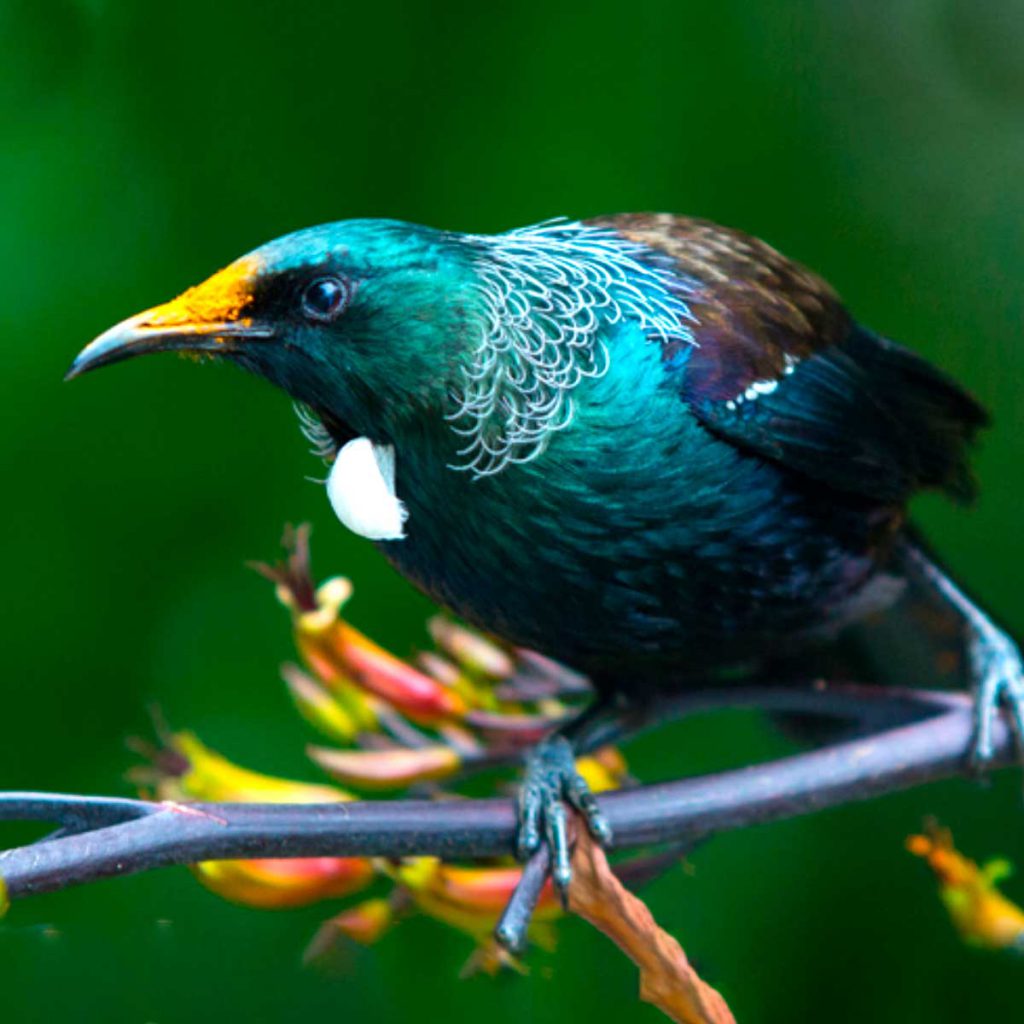
Birds / Tui
Information for Juniors
Tui
- Maori name is Mohua – Parson Bird
- Known as the parson bird because of the white tuft on its neck
- Largest honey eater, related to the Bellbird
- Basically, black feathered bird shines blue/green in the sun with white tuft on its neck
- Enjoys the company of the Bellbird, Wood Pigeon and Silver Eye
- Very boisterous, loud bird that likes showing off
- Strong powerful bird especially in spring
- Especially loves nectar/honey from the flax and kowhai flowers
- Produces 2-4 white/pink eggs with brown spots
- Female does all the nesting, the male helps feed the chicks
- The nests are rough and bulky made of twigs, sticks and grass
- Can imitate sounds so its song changes frequently
What does it sound like?

Information for Junior Secondary
Tui
- Maori name is Mohua – Parson Bird
- Known as the parson bird because of the white tuft on its neck
- Largest honey eater, related to the Bellbird
- Basically, black feathered bird shines blue/green in the sun with white tuft on its neck
- Enjoys the company of the Bellbird, Wood Pigeon and Silver Eye
- Very boisterous, loud bird that likes showing off
- Strong powerful bird especially in spring
- Especially loves nectar/honey from the flax and kowhai flowers
- Produces 2-4 white/pink eggs with brown spots
- Eggs are laid from September to January
- Female does all the nesting, the male helps feed the chicks
- The nests are constructed by the female, they are rough and bulky made of twigs, sticks and grass
- Tuis are aggressive and will defend their territory
- They pollinate the flowering plants and disperse seeds all over the forest in their droppings
- Can imitate sounds so its song changes frequently.
What does it sound like?

Information for Senior Secondary
Tui
- Maori name is Mohua – Parson Bird
- Its order is Passeriformes and its family is Meliphagidae
- Found throughout NZ though colours slightly change from region to region
- Males tend to be larger than the female
- Known as the parson bird because of the white tuft on its neck
- Largest honey eater, related to the Bellbird
- Their diet is varied but includes nectar, honey and fruit from trees like Puriri, Kowhai, Rewarewa, Flax, Pohutukawa
- Basically, black feathered bird shines blue/green in the sun with white tuft on its neck
- Enjoys the company of the Bellbird, Wood Pigeon and Silver Eye
- Very boisterous, loud bird that likes showing off
- Strong powerful bird especially in spring
- Especially loves nectar/honey from the flax and kowhai flowers
- Produces 2-4 white/pink eggs with brown spots
- Eggs are laid from September to January
- Female does all the nesting, the male helps feed the chicks
- Again the threats are possums, rats, stoats and hawks
- The nests are constructed by the female, they are rough and bulky made of twigs, sticks and grass
- Tuis are aggressive and will defend their territory
- They pollinate the flowering plants and disperse seeds all over the forest in their droppings
- Can imitate sounds so its song changes frequently
- Their song can be prolonged and interspersed with coughs and grunts. In flight repetitive screams
What does it sound like?

NZ Tui Activities
- Why is the white tuft symbolic?
- Describe the fighting pattern of the Tui’s flight
- How does the Tui protect its territory and from what?
- What colours can you observe?
